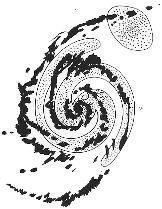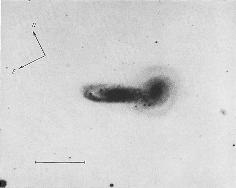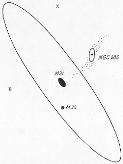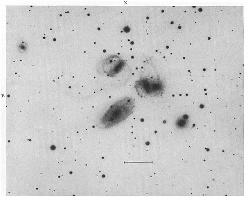


3. Coexisting galaxies. Several individual galaxies obviously may form a permanent multiple dynamic system, if their relative velocities are too small to result in an ultimate separation. Actually the members of a permanent group can coexist, occupying the same volume of space, although this remarkable fact has not in the past been duly emphasized. In the case of our own galaxy, for instance, it has long been recognized that it is made up of sub-systems which, dynamically and historically seem to have gone through independent evolutions. Three of these sub-systems are (1) the Milky Way system proper, which is thought to be a spiral galaxy, (2) the large globular system in which the spiral system is imbedded and whose outskirts reach far outside of the flattened spiral, and (3) the globular clusters, most of which are generally being associated with the globular subsystem of our galaxy. From their appearance and behavior, we may, however, consider the globular star clusters as independent stellar systems, especially if statistical mechanical problems of the type relating to the theory of the luminosity function of galaxies are discussed [3], [9]. Globular clusters of stars are also known to be associated with many other galaxies, such as the Sb spiral Messier 31 (the Andromeda nebula), the more irregular Magellanic clouds, the globular galaxy NGC 4486 and dwarf galaxies such as the Fornax system [10].
Most remarkable among the coexisting galaxies is a discovery made with the help of the so-called analytical composite photography, recently developed by F. ZWICKY [6], [7] for the study of the differently colored luminous populations of stellar systems. An analysis of the Whirlpool nebula (Messier 51) by means of this type of photography revealed that, while the blue stars form a disrupted and very poorly organized spiral structure, the yellow-green stars have arranged themselves in a highly streamlined spiral with smoothly distributed surface luminosity [9]. Furthermore, this latter spiral is of the barred type, while the blue population structure is a normal spiral. In Fig. 1 we give a schematic representation of these startling facts.

|
Figure 1. Coexistence of a blue normal and a yellow-green barred spiral galaxy within the brighter member (NGC 5194) of the Whirlpool nebula, Messier 51. The barred spiral and the "elliptical" companion NGC 5195 are indicated by solid line contours within which the dotted yellow-green population is distributed with remarkable uniformity. The blue normal spiral is sketched by means of the black shaggy spots. |
Astronomers, until recently, following HUBBLE'S classification [11], have assumed universally that normal spirals (S) and barred spirals (SB) represent two entirely different evolutionary sequences, and numerous theoretical investigations have attempted to explain these sequences. With the discovery that normal and barred spiral structures can coexist within the same galaxy, the whole problem of the structure and of the evolution of stellar systems must be viewed from an entirely new perspective.
As a consequence of the recognition of the possible coexistence of widely different structural types of galaxies one naturally suspects that such coexistence might be a rather general phenomenon. Indeed, a preliminary search indicates, that probably all of HUBBLE'S original types [11] can coexist in any combination one may wish to choose. While this poses entirely new and unsuspected problems for the theoretical astronomers, it shows before all, that HUBBLE'S classification of stellar systems must now be considered as rather obsolete in the sense that it will have to be replaced by a far more refined morphology of galaxies, if such a morphology is to serve as a sound observational basis for future theories. One of the first fascinating problems of such theories will be to analyze just how long two stellar systems of different structures can coexist without markedly influencing one another or without entirely loosing their individuality. One of the simplest problems in this category is that related to the perturbations which the various material components and the gravitational and electromagnetic fields of our own galaxy exert on the globular and on the open star clusters which are located within its confines. It will be worthwhile to search for observable effects of this type on the structure of the star clusters in the Milky Way system.
4. Clearly separated systems. Multiple systems which consist of clearly separated individual galaxies may be of two types. The structures of the individual component galaxies may more or less clearly reveal disturbances such as tidal actions caused by the proximity of the other galaxies in the system, or, no effects of this kind may be readily in evidence. In this latter case the proximity in space of two galaxies can be proved only through rather elaborate investigations, resulting in accurate distance determinations of the individual components of the suspected double galaxy. The present writer is not convinced that sufficient proof has been furnished in any particular case that any two optically close and structurally undisturbed galaxies are really close neighbors in space and that they actually form a dynamically stable unit.
Among the members of the Local Group of galaxies, for instance,
Messier 31
(the great nebula in Andromeda), Messier 32 and NGC 205, 147 and 185 are
supposed to constitute a dynamic unit. While some tidal distortions possibly
exist in NGC 205 no effects of this kind are certainly
discernible in the other
four galaxies. The view that we here deal with a dynamic unit of five stellar
systems therefore derives its main support from the fact that the distances of
the individuals, as so far determined
[12],
seem to be roughly the same. The
small dispersion in radial velocities indicates that the systems cannot escape
from one another, although this conclusion might of course be vitiated by large
tangential components of the velocities. The radial velocities for four of the
galaxies, as given by HUMASON
[13]
are Vs = c .

 /
/  = -266, -214, -239
and -266 km/sec for Messier 31, Messier 32, NGC 205 and NGC 185 respectively.
(c = velocity of light,
= -266, -214, -239
and -266 km/sec for Messier 31, Messier 32, NGC 205 and NGC 185 respectively.
(c = velocity of light,

 = displacement of a spectral line whose unshifted
wavelength is
= displacement of a spectral line whose unshifted
wavelength is  ).
).
A similar problem exists with respect to some of the small stellar systems on the far outskirts of the Milky Way system. Again, the globular cluster NGC 2409 and the dwarf Capricorn stellar system, of the type of a medium open cluster, may be independent dwarf galaxies, or their velocities may be so small that together with our own galaxy they constitute a dynamically stationary multiple galaxy.
The optical double galaxy is another type of system the interpretation of whose real nature is problematic. One of these cases is shown in Fig. 2.

|
Figure 2. Optical Double Nebulae NGC 5544 to 5543 at R. A. = 14h14m53S, Decl. + 36°44'20" (1950). Somewhat out of context it may be added that the field back of the double galaxy contains an extremely distant and richly populated medium compact cluster of galaxies, which is one of the few discovered with the 200-inch telescope and not readily visible on plates taken with the 48-inch Schmidt telescope. Scale indicates one minute of arc. |
According to TH. PAGE
[14]
the first member, NGC 5544, of the double
system in Fig. 2 has a redshift corresponding to
a symbolic velocity of recession
equal to Vs = (3090 ± 70) km/sec, while its
companion NGC 5545 has V's =
Vs +
 Vs, where
Vs, where
 Vs = (10
± 100) km/sec. PAGE erroneously lists both galaxies as
of the elliptical type, whereas they are smoothly wound spirals. The practical
equality of the values of Vs for the two galaxies
suggests that they are close
neighbors in space, although there is no other check available so far for this
conclusion, since no tidal action between the two systems can be seen. The
author has, however, in similar cases succeeded in photographing very faint
tidal extensions, and he has also attempted to obtain such evidence for
NGC 5544
to 5545. Unfortunately, the night sky has recently been
so bright, because of
solar activity, that the search for extremely faint tidal extensions must be
postponed until a later date.
Vs = (10
± 100) km/sec. PAGE erroneously lists both galaxies as
of the elliptical type, whereas they are smoothly wound spirals. The practical
equality of the values of Vs for the two galaxies
suggests that they are close
neighbors in space, although there is no other check available so far for this
conclusion, since no tidal action between the two systems can be seen. The
author has, however, in similar cases succeeded in photographing very faint
tidal extensions, and he has also attempted to obtain such evidence for
NGC 5544
to 5545. Unfortunately, the night sky has recently been
so bright, because of
solar activity, that the search for extremely faint tidal extensions must be
postponed until a later date.
5. Interconnected galaxies.
 ) Close pairs or groups.
Here a perfectly
bewildering multitude of morphological types exist which it is quite impossible
to classify at the present time. The sky survey with the 48-inch Schmidt
telescope has brought to light tens of thousands of interconnected
galaxies with
separations up to say three diameters of the main bodies of the
individual galaxies
involved. In the limit, these bodies may hardly be separated at all and
may coexist in the sense discussed in Sect. 3.
) Close pairs or groups.
Here a perfectly
bewildering multitude of morphological types exist which it is quite impossible
to classify at the present time. The sky survey with the 48-inch Schmidt
telescope has brought to light tens of thousands of interconnected
galaxies with
separations up to say three diameters of the main bodies of the
individual galaxies
involved. In the limit, these bodies may hardly be separated at all and
may coexist in the sense discussed in Sect. 3.
The only general statements we can make here are as follows.
(a) All simple types of galaxies, as originally classified by HUBBLE [11] may appear interconnected. Normal spirals, barred spirals, globular, elliptical and irregular galaxies form double galaxies in all conceivable combinations.
(b) The connections may be filaments which are extensions of structural features of the individual galaxies, such as their spiral arms. On the other hand many filamentary and bridgelike links have been found which have no direct relation to any of the said structural features, and finally two or more galaxies may appear imbedded in a more or less diffuse luminous cloud.
(c) The luminous connections between galaxies seem to consist most frequently of stars. In a few special cases the existence of gases has been traced from emission lines. From certain striking features such as annular absorption rings it is practically certain that some of the bridges between neighboring galaxies also contain dust, a result which is naturally to be expected if the bridges are formed as a result of close encounters of stellar systems.
(d) The discovery, discussed in Sect. 3, that different structural types of galaxies can coexist within the same volume of space, makes us suspect that the morphological possibilities of the interconnections between two galaxies are far more complex than was stated above in paragraph (a). Indeed, we must now inquire which particular structure or which structures within one system of coexisting galaxies is interconnected with which structure in the companion galaxy. In this sense it would for instance be of the greatest interest to unravel the detailed morphological features of the Whirlpool Nebula Messier 51, a sketch of which is shown in Fig. 3 [reprinted from Physics Today 6, No. 4, 7-11 (1953)].

|
Figure 3. The whirlpool Nebula. The heavy lines show the structure of the double nebula as it has long been known. The crosses indicate a flare (I) as it appears clearly on photographs obtained with the Schmidt telescopes. The shaded parts II are extremely faint. They were originally discovered by G. W. RITCHEY [Decennial Publ. Univ. Chicago 8, 397 (1904)], and they were later also photographed by M. DE KEROLYR. For reasons unknown, these original findings were practically forgotten by most of the experts in the field until ZWICKY [7], [15] rediscovered the formation II and showed by his method of composite photography that it is presumably this very broad and faint spiral arm which connects NGC 5194 and NGG 5195, rather than the very much more pronounced narrow and luminous spiral arm S. The reality of the faint dotted cloud (III) is still in doubt. The seven large dots represent some of the foreground stars. |
The Whirlpool Nebula is being photographed by the author in five color ranges, infrared, red, yellow green, blue and ultraviolet with the intention of using all combinations between these ranges for the construction of composite photographs [9], [15]. These composites are expected to reveal much concerning the individual structures of the two components of the Whirlpool Nebula and how they are interconnected. So far, only the combination of blue and of yellow-green is available. From this combination it was deduced that NGC 5194 is a poorly organized normal spiral in the blue population of stars while it appears as an exceedingly smooth open barred spiral structure in the yellow-green population. On the other hand, NGC 5195 seems to be irregular in the blue and perhaps an elliptical or Theta barred spiral in the yellow-green. As stated before, the brighter spiral arm seems to miss the companion NGC 5195, at least as far as the blue population is concerned. From this we conclude that the two spiral arms of NGC 5194 do not lie in one plane. We may expect the structural features of the whole system to become still more complicated if it should be found that the individual spiral arms of the different color populations do not really coincide.
Starting from our own immediate neighborhood, the problem of whether or not the Milky Way system and the two Magellanic clouds are all interconnected and in what manner, presents one of the most fascinating and difficult problems. As Professor KNUT LUNDMARK first pointed out to the author in 1952, Sir J.F.W. HERSCHEL had already watched in South Africa, in 1838, for a bridge between the Milky Way and the Large Magellanic Cloud and had written as follows [16]:
"Entirely without telescopic aid, when seated at a table in the open air, in the absence of the moon I scanned the southern skies from a South African Observatory at the Cape of Good Hope and found that no branch of the Milky Way whatsoever forms any certain and conspicuous junction with the Nubecula Major; though on very clear nights I have sometimes fancied a feeble extension of the nearer portion of the Milky Way in Argo (where it is not above 15° or 20° distinct) in the direction of the Nubecula".
The present author subsequently contacted a number of Australian astronomers and radio astronomers about the matter. While Dr. G. DE VAUCOULEURS attempted by various optical methods to explore interconnections between the three neighboring systems and also searched for a countertide on the opposite side of the Milky Way, the radio astronomers derived intensity contour lines which give some support for the assumption that extensions of the three systems towards one another exist. Because of the intervening effects of complicated and rich more nearby clouds of stars, gases and dust, much more and painstaking work will be needed to clear up the question of any interconnecting formations between the Milky Way and the Magellanic Clouds.
As far as the next nearest optically visible group of galaxies is concerned, we already mentioned that among the group of five stellar systems around the great nebula in Andromeda only NGC 205 shows any structural features which might be interpreted as being due to the gravitational field of Messier 31 itself. On plates obtained with the 48-inch Schmidt telescope, NGC 205 clearly appears as an open barred spiral, one of whose extensions is pointing towards the center of Messier 31 and which might be interpreted as a direct tide, while the symmetrical countertide points in the opposite direction, as shown in Fig. 4.

|
Figure 4. Schematic drawing of the structural relation between the Great Nebula in Andromeda and its fainter companion NGC 205. |
In Fig. 5 we give sketches of a few of the very many types of connections between neighboring galaxies. It is seen for instance that for normal and barred spirals all conceivable relative configurations occur a fact which indicates strongly that these configurations are the result of double or multiple encounters.

|
Figure 5. Some of the many types of bridge and filament connections observed between neighboring galaxies. |
Finally, in conclusion of this section, two photographs obtained with the 200-inch telescope are reproduced in Figs. 6 and 7, showing one interconnected pair and the famous Stepan Quintet.

|
Figure 6. NGC 5257 to 5258 at R.A. 13h37m12S, Decl. + 1°0'13" (1950.0), photographed on Eastman 103 a-O emulsion, exposure 40 min, with the 200-inch telescope. According to TH. PAGE [14] the symbolic velocities of recession for the two galaxies are respectively Vs = 6600 and V's = 6485 km/sec. This is one of the systems originally observed by F. G. PEASE [1]. Scale indicates one minute of arc. |

|
Figure 7. Photograph with the 200-inch telescope on Eastman 103 a-D plate behind GG11 Schott glass fitter of STEPAN'S Quintet, NGC 7317, 7318a, 7318b, 7319, 7320 at R.A. 22h33m43S and Decl. + 33°42' (1950.0). The symbolic velocities of recession of the four first mentioned galaxies, which are respectively of the types E4, E2, SBb and SBb are Vs = 6736, 6638, 5638, and 6657 km/sec. Notice that there is a difference of 1100 km/sec between the first and the third members of the group. If the group is a permanent dynamic on it, its total mass must be large enough to retain NGC 7318b. If we adopt HUBBLE'S old distance scale, corresponding to a value of Vs = 550 km sec per million parsecs the distance of the group would be about twelve million parsecs, its diameter of the order of 16000 parsecs and its mass, it the group is permanent, is greater than 1012 times the mass of the Sun. Adopting any of the more recent expanded distance scales, the mass of the system would have to be greater still, if it is not eventually to loose any of its members. Scale = 1' arc. |
 ) Groups of
widely separated interconnected galaxies. With wide
separation
we mean those groups in which the individual galaxies are either separated by
more than three diameters or which show filaments, luminous clouds or tidal
spurs which are many times as extended as the main bodies of the galaxies
proper. The discovery and the subsequent exploration of these interesting
structures is mainly due to the present author and the results, as available at
the present time, have been discussed by him in an extended paper
[5]. In
order to avoid unnecessary duplication, we therefore refer the
interested reader
to this article as well as to a recent review of the subject by Professor OTTO
STRUVE in "Sky and Telescope" Vol. XVI, 162-166 (1957). Since, however,
good photographs are not easily obtained of extended luminous intergalactic
formations, we reproduce in the Figs. 8,
9 and 10 a few systems
not included
in the original article in the Ergebnisse Vol. 29
[5].
) Groups of
widely separated interconnected galaxies. With wide
separation
we mean those groups in which the individual galaxies are either separated by
more than three diameters or which show filaments, luminous clouds or tidal
spurs which are many times as extended as the main bodies of the galaxies
proper. The discovery and the subsequent exploration of these interesting
structures is mainly due to the present author and the results, as available at
the present time, have been discussed by him in an extended paper
[5]. In
order to avoid unnecessary duplication, we therefore refer the
interested reader
to this article as well as to a recent review of the subject by Professor OTTO
STRUVE in "Sky and Telescope" Vol. XVI, 162-166 (1957). Since, however,
good photographs are not easily obtained of extended luminous intergalactic
formations, we reproduce in the Figs. 8,
9 and 10 a few systems
not included
in the original article in the Ergebnisse Vol. 29
[5].